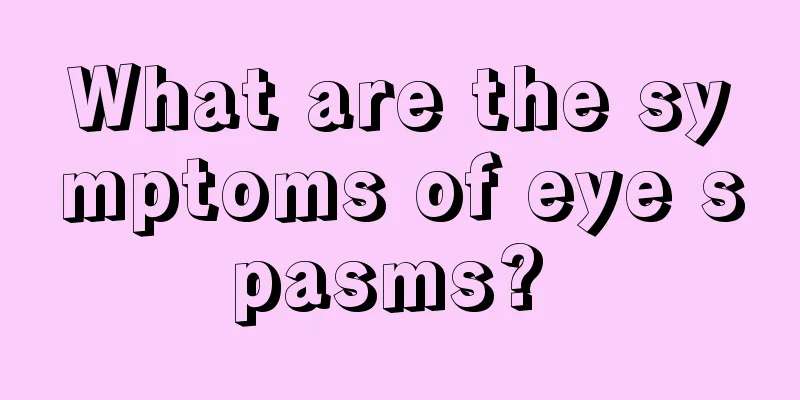What are the symptoms of eye spasms?

|
Blepharospasm is very common among middle-aged and elderly people and it is a neurological disease. The occurrence of eye spasms can cause great trauma to the patient's physical and psychological health. It will also affect the appearance. Eye spasms are also easy to misdiagnose. Many people go through a lot of torture and pain before they are diagnosed. Let’s take a look at the common manifestations of eye spasms. Clinical manifestations of eye spasms: (1) Primary blepharospasm: It is caused by spasmodic contraction of the orbicularis oculi muscle, resulting in involuntary closure of the eyelids. It is often a bilateral lesion with progressive progression. 2/3 are women, and most develop the disease over the age of 60. The cause is unknown. The frequency and duration of spasms vary. In mild cases, the orbicularis oculi muscle has paroxysmal, frequent small twitches that do not affect eye opening. In severe cases, the twitching is obvious, making it difficult to open the eyes, affecting vision and causing functional blindness. In most patients, symptoms stabilize within 3 to 5 years. One-third of patients have associated movement abnormalities, such as Meige syndrome, essential tremor, or Parkinson's disease. Secondary blepharospasm caused by keratoconjunctivitis, trichiasis, and blepharitis should be excluded during diagnosis. The drug and physical treatments for this disease include: clonazepam, Antan, acupuncture, percutaneous facial nerve thermolysis, etc., but all have little effect. Surgical treatments include: orbicularis oculi muscle and eyebrow muscle muscle resection combined with browplasty and levator palpebrae superioris muscle reinforcement, and selective facial nerve extraction combined with muscle stripping. However, these methods are not ideal. The side effects of the former include: forehead numbness and eyelid edema, and the latter may have serious complications of facial nerve paralysis, manifested as ptosis, lagophthalmos, corneal exposure, and ectropion. 50% of patients relapse after surgery. (ii) Hemifacial spasm: It is a unilateral lesion with periodic tonic contraction of facial muscles. Spasms usually begin in the orbicularis oculi muscle and gradually spread to other parts of the area and can occur during sleep or wakefulness. It usually starts in middle age and is more common in women. May be accompanied by unilateral facial muscle weakness. The cause is usually compression of the seventh cranial nerve root by vascular structures or a tumor at the cerebellopontine angle. Vascular lesions account for 90% of cases, and less than 1% of cases are due to posterior fossa tumors. Drug treatment includes carbamazepine, diazepam, phenytoin sodium, etc., as well as biofeedback, and surgical treatment includes muscle resection. Selective facial nerve resection. However, complications such as hearing loss, otitis media, and cerebrospinal fluid leakage may occur. |
<<: What are the symptoms of Yin deficiency fever?
>>: What are the symptoms of lung stones?
Recommend
What are the contraindications of the Butterfly brand?
Many people may not know about the Butterfly amul...
Cholestasis of pregnancy_Symptoms of cholestasis during pregnancy
Cholestasis of pregnancy is a very common gynecol...
Are woodlice harmful to human body?
Woodlice are harmful to the human body, for examp...
What to do if you are stung by a bee
Being stung by bees is a very common thing in lif...
What should I do if small cell lung cancer metastasizes to the liver?
What should I do if small cell lung cancer metast...
Sub-health is not scary, the key is to insist on "prevention"
How to alleviate sub-health is an urgent matter. ...
Can onions cure insomnia? How to do it
Scallions are very common in our daily life. They...
Can Biostime enhance immunity?
Biostime probiotics are very common in real life ...
Right middle lobe bronchiectasis
Lungs are the main part of the human respiratory ...
What are tumor autoantibodies? Click here, you can find everything you want
"Tumor autoantibodies" are also called ...
What to do if short hair sticks up at the back
Hair is a very important part of the upper body. ...
Is type O blood a universal blood type?
There is a special protein on the surface of our ...
TCM treatments for ovarian cancer Which Chinese medicines can treat ovarian cancer
There are many TCM treatments for ovarian cancer....
Five major advantages of interventional treatment for liver cancer Risk assessment of interventional treatment for liver cancer
Interventional treatment for liver cancer is a mi...
How to effectively prevent bile duct cancer
Biliary duct cancer is even more dangerous than p...









